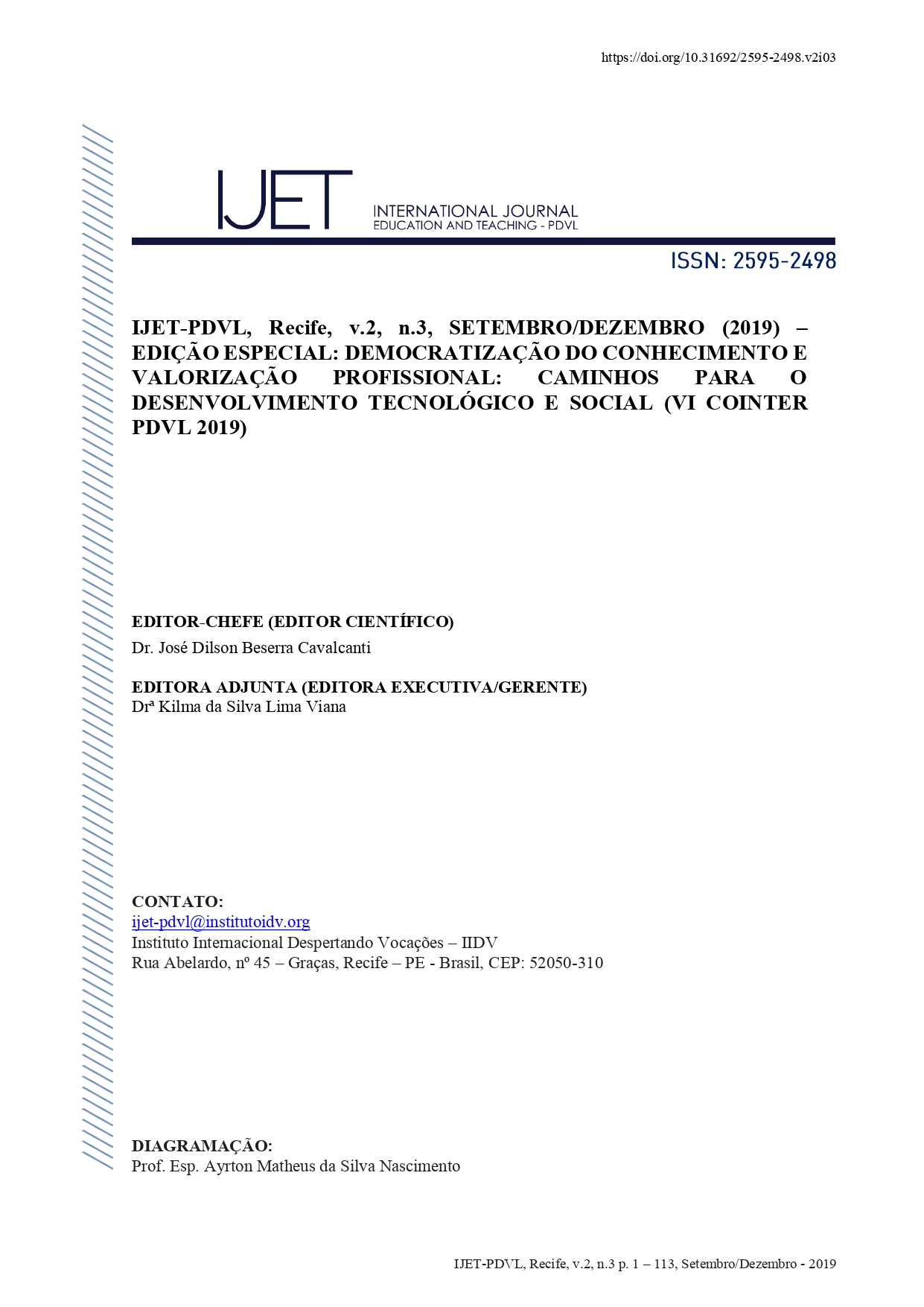ANALYSIS OF THE APPROACH TO THE AREA OF FLAT FIGURES PROPOSED BY THE COMMON NATIONAL CURRICULUM FOR THE PROCESS OF TEACHING AND LEARNING MATHEMATICS IN BASIC EDUCATION
DOI:
https://doi.org/10.31692/2595-2498.v2i3.99Keywords:
Common National Base Curriculum, Area, Basic Education, MathematicsAbstract
This research aims to analyze the treatment of the area proposed by the Common National Curriculum Base for the process of teaching and learning of mathematics in basic education. For this, it was based on the notion of the conceptualization of area proposed by Régine Douady and Perrin-Glorian in which they argue that in order to construct the concept of area it is interesting to articulate the geometrical, numerical and quantity frames. In order to achieve the main purpose of the present research, in methodological terms, the results were categorized in two moments, the first being to quantify the total of objects of knowledge and skills that contemplate the area content of flat figures, while in the Secondly, we analyze whether the resolutive emphasis of skills rests most heavily on the geometric or numerical framework, or both, for addressing area content throughout basic education. The results express that the objects of knowledge and skills proposed by the Common National Curriculum Base for the process of teaching and learning in basic education consider more predominantly the numerical framework for the exploration of the contents of areas of flat figures. We also verified that the results indicate that the emphasis on knowledge skills to explore the concept area is supported by the numerical aspects, through the tiling process and the use of formulas. The National Common Curriculum Base emphasizes that numerical aspects are essential for understanding the knowledge of the area, however we hoped that there would be a greater geometric treatment to explore situations of surface production, comparisons of areas relegating the numerical aspect, etc., elements that are in background considering all stages of basic education. With the result of this investigation we hope to contribute to the reflection of the critical thinking of the researchers that investigate the geometrical quantities, in particular, the area in order to look at the present curriculum guidance document and to verify all its potentialities and limitations that are offered to the researcher. teaching and learning process in the Mathematics discipline.
Downloads
References
BALTAR, P. M. Enseignement et apprentissage de la notion d’aire de surfaces planes: une étude de l’acquisition des relations entre les longuers et les aires au collège. 1996. Tese (Doutorado em Didática da Matemática), Université Joseph Fourier, Grenoble, França, 1996.
BELLEMAIN, P.; LIMA, P. Um estudo da noção de grandeza e implicações no Ensino Fundamental. Ed. Geral: John A. Fossa. Natal: SBHMat, 2002.
BRASIL, S. E. F. Base Nacional Curricular Comum- BNCC. Brasília, 2018, p.600.
DOUADY, R.; PERRIN-GLORIAN, M. J. Un processus d’apprentissage du concept d’aire de surface plane. Educational Studies in Mathematics.v.20, n.4, p. 387-424, 1989. DOI: https://doi.org/10.1007/BF00315608
FERREIRA, L. F. D. A construção do conceito de área e da relação entre área e perímetro no 3º ciclo do ensino fundamental: estudos sob a ótica da teoria dos campos conceituais. 2010. 191f. Dissertação (Mestrado em Educação). Centro de Educação, Universidade Federal de Pernambuco, Recife, 2010. Disponível em: < https://repositorio.ufpe.br/bitstream/123456789/3972/1/arquivo206_1.pdf > acessado em 09/10/2019.
PERNAMBUCO, S. Currículo de Matemática para o Ensino Fundamental com base nos Parâmetros Curriculares do Estado de Pernambuco, Recife, SEDUC-PE, 2012.
SANTOS, M. R. A Transposição Didática do conceito de área de figuras geométricas planas no 6º ano do ensino fundamental: um olhar sob a ótica da Teoria Antropológica do Didático. 2015. 281 f. Tese (Doutorado em Ensino das Ciências e Matemática) – Universidade Federal Rural de Pernambuco, Recife, 2015. Disponível em: <http://www.tede2.ufrpe.br:8080/tede/bitstream/tede2/5375/2/Marilene%20Rosa%20dos%20Santos.pdf> acesso em: 07/10/2019.
SILVA, A. D. P. R. Ensino e Aprendizagem de Área Como Grandeza Geométrica: um estudo por meio dos ambientes papel e lápis, materiais manipulativos e no Apprenti Géomètre 2 no 6º ano do ensino fundamental. 2016. 317 f. Dissertação (Educação Matemática e Tecnológica). Universidade Federal de Pernambuco, Centro de Educação. Recife, 2016. Disponível em: < https://repositorio.ufpe.br/handle/123456789/17427> acesso em 12/10/2019.
Downloads
Published
Conference Proceedings Volume
Section
License
Copyright (c) 2019 Franklin Fernando Ferreira Pachêco, Andreza Santana da Silva, Alan Gustavo Ferreira (Autor)

This work is licensed under a Creative Commons Attribution 4.0 International License.






